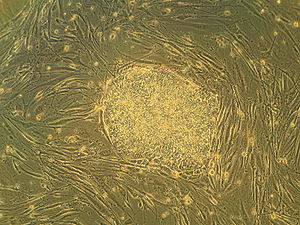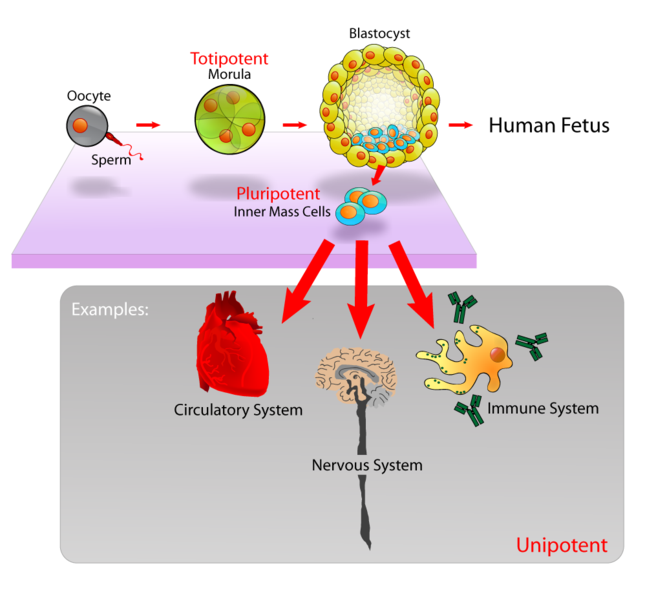Embryonic stem cell
Overview


Embryonic stem cells (ES cells) are stem cells derived from the inner cell mass of an early stage embryo known as a blastocyst. Human embryos reach the blastocyst stage 4-5 days post fertilization, at which time they consist of 50-150 cells.
ES cells are pluripotent. This means they are able to differentiate into all derivatives of the three primary germ layers: ectoderm, endoderm, and mesoderm. These include each of the more than 220 cell types in the adult body. Pluripotency distinguishes ES cells from multipotent progenitor cells found in the adult; these only form a limited number of cell types. When given no stimuli for differentiation, (i.e. when grown in vitro), ES cells maintain pluripotency through multiple cell divisions. The presence of pluripotent adult stem cells remains a subject of scientific debate, however, research has demonstrated that pluripotent stem cells can be directly generated from adult fibroblast cultures.[1].
Because of their plasticity and potentially unlimited capacity for self-renewal, ES cell therapies have been proposed for regenerative medicine and tissue replacement after injury or disease. However, to date, no approved medical treatments have been derived from embryonic stem cell research (ESCR). Adult stem cells and cord blood stems cells have thus far been the only stem cells used to successfully treat any diseases. Diseases treated by these non-embryonic stem cells include a number of blood and immune-system related genetic diseases, cancers, and disorders; juvenile diabetes; Parkinson's; blindness and spinal cord injuries. Besides the ethical problems of stem cell therapy (see stem cell controversy), there is a technical problem of graft-versus-host disease associated with allogeneic stem cell transplantation. However, these problems associated with histocompatibility may be solved using autologous donor adult stem cells or via therapeutic cloning.
Research history and developments
Isolation and in vitro culture
Stem cells were discovered from analysis of a type of cancer called a teratocarcinoma. In 1964, researchers noted that a single cell in teratocarcinomas could be isolated and remain undifferentiated in culture. These types of stem cells became known as embryonic carcinoma cells (EC cells).[2] Researchers learned that primordial embryonic germ cells (EG cells) could be cultured and stimulated to produce many different cell types.
Growing cells in a laboratory is known as cell culture. Human stem cells are isolated by transferring the inner cell mass into a plastic laboratory culture dish that contains a broth known as culture medium. What are embryonic stem cells? . In Stem Cell Information [World Wide Web site]. Bethesda, MD: National Institutes of Health, U.S. Department of Health and Human Services, 2006 [cited Tuesday, April 10, 2007] Available at <http://stemcells.nih.gov/info/basics/basics3>
Embryonic stem cells (ES cells) were first derived from mouse embryos in 1981 by Martin Evans and Matthew Kaufman and independently by Gail R. Martin. Gail R. Martin is credited with coining the term 'Embryonic Stem Cell'.[3][4] A breakthrough in human embryonic stem cell research came in November 1998 when a group led by James Thomson at the University of Wisconsin-Madison first developed a technique to isolate and grow the cells when derived from human blastocysts.[5]
Production of male gametes
Researchers at the Whitehead Institute announced in 2003 that they had successfully used embryonic stem cells to produce haploid, male gametes. They found embryonic stem cells that had begun to differentiate into embryonic germ cells and then further differentiated into the male haploid cells. When injected into oocytes, these haploid cells restored the somatic diploid complement of chromosomes and formed blastocysts in vitro.[6]
Contamination by reagents used in cell culture
The online edition of Nature Medicine published a study on January 23, 2005 which stated that the human embryonic stem cells available for federally funded research are contaminated with non-human molecules from the culture medium used to grow the cells. It is a common technique to use mouse cells and other animal cells to maintain the pluripotency of actively dividing stem cells. The problem was discovered when non-human sialic acid in the growth media was found to compromise the potential uses of the embryonic stem cells in humans, according to scientists at the University of California, San Diego.[7]
However, a study was published in the online edition of Lancet Medical Journal on March 8, 2005 detailed information about a new stem cell line which was derived from human embryos under completely cell- and serum-free conditions. After more than 6 months of undifferentiated proliferation, these cells demonstrated the potential to form derivatives of all three embryonic germ layers both in vitro and in teratomas. These properties were also successfully maintained (for more than 30 passages) with the established stem cell lines. [8]
Reducing donor-host rejection
There is also ongoing research to reduce the potential for rejection of the differentiated cells derived from ES cells once researchers are capable of creating an approved therapy from ES cell research. One of the possibilities to prevent rejection is by creating embryonic stem cells that are genetically identical to the patient via therapeutic cloning.
An alternative solution for rejection by the patient to therapies derived from non-cloned ES cells is to derive many well-characterized ES cell lines from different genetic backgrounds and use the cell line that is most similar to the patient; treatment can then be tailored to the patient, minimizing the risk of rejection.
Potential method for new cell line derivation
On August 23, 2006, the online edition of Nature scientific journal published a letter by Dr. Robert Lanza (medical director of Advanced Cell Technology in Worcester, MA) stating that his team had found a way to extract embryonic stem cells without destroying the actual embryo.[9] This technical achievement would potentially enable scientists to work with new lines of embryonic stem cells derived using public funding. Federal funding is currently limited to research using embryonic stem cell lines derived prior to August 2001.
In the experiments, Lanza's team used a single-cell biopsy technique to pluck out a single cell when the embryo was at the 8-to-10 cell stage. This is the same stage used for preimplantation genetic diagnosis, which also requires the removal of a single cell from the blastocyst. As with times where preimplantation genetic diagnosis is used, excising a cell at this point does not interfere with the embryo's development and the excised cell can be used for both purposes at the same time. Using this method, Lanza and his team managed to get two stable human embryonic stem cell lines that behaved like conventional embryonic stem cell lines.
Quickly after its publication, this paper came under some criticism for its representation of the facts. Examination of the paper revealed that the described process was highly inefficient, and in addition, no embryos survived the process. [10] Dr. Lanza states that "he never intended to say more than that he had proved a principle"[11]. The goal of the paper was to demonstrate that an embryonic stem cell line could be derived from a single cell from the inner mass. Given that the embryos in the study were not medically or legally eligible for implantation, more than one cell was removed from the inner cell masses - each to be used in a separate experiment.
At the 2007 meeting of the International Society for Stem Cell Research (ISSCR) [12], Dr. Lanza announced that his team had succeeded in producing three new stem cell lines without destroying the parent embryos. "These are the first human embryonic cell lines in existence that didn't result from the destruction of an embryo." Lanza is currently in discussions with the National Institutes of Health (NIH) to determine whether the new technique sidesteps U.S. restrictions on federal funding for ES cell research [13]. Advanced Cell Technology has pledged cooperation with WiCell Research Institute to derive new stem cell lines using the principle of the Lanza paper, pending federal approval and further research. [14]
Professor Yamanaka, Japan’s leading genetics researcher, had a recent breakthrough in which the skin cells of laboratory mice were genetically manipulated back to their embryonic state.
References
- ↑ [http://www.cell.com/content/article/abstract?uid=PIIS0092867406009767&highlight=Yamanaka Department of Stem Cell Biology, Institute for Frontier Medical Sciences, Kyoto University, Kyoto],Induction of Pluripotent Stem Cells from Mouse Embryonic and Adult Fibroblast Cultures by Defined Factors, August 25, 2006
- ↑ Andrews P, Matin M, Bahrami A, Damjanov I, Gokhale P, Draper J (2005). "Embryonic stem (ES) cells and embryonal carcinoma (EC) cells: opposite sides of the same coin". Biochem Soc Trans. 33 (Pt 6): 1526–30. PMID 16246161.
- ↑ Evans M, Kaufman M (1981). "Establishment in culture of pluripotential cells from mouse embryos". Nature. 292 (5819): 154–6. PMID 7242681.
- ↑ Martin G (1981). "Isolation of a pluripotent cell line from early mouse embryos cultured in medium conditioned by teratocarcinoma stem cells". Proc Natl Acad Sci U S A. 78 (12): 7634–8. PMID 6950406.
- ↑ Thomson J, Itskovitz-Eldor J, Shapiro S, Waknitz M, Swiergiel J, Marshall V, Jones J (1998). "Embryonic stem cell lines derived from human blastocysts". Science. 282 (5391): 1145–7. PMID 9804556.
- ↑ http://www.nature.com/nature/journal/v427/n6970/abs/nature02247.html
- ↑ http://www.nature.com/nm/journal/v11/n2/pdf/nm1181.pdf
- ↑ http://www.thelancet.com/journals/lancet/article/PIIS0140673605664732/fulltext (Lancet Medical Journal)
- ↑ Klimanskaya I, Chung Y, Becker S, Lu SJ, Lanza R. (2006). "Human embryonic stem cell lines derived from single blastomeres". Nature. 444 (7118): 481–5. PMID 16929302.
- ↑ 'Ethical' stem-cell paper under attack
- ↑ http://www.nature.com/nature/journal/v443/n7107/full/443012a.html
- ↑ http://abcnews.go.com/Health/wireStory?id=3307505
- ↑ http://sciencenow.sciencemag.org/cgi/content/full/2007/619/3
- ↑ http://www.advancedcell.com/press-release/wicell-research-institute-and-advanced-cell-technology-offer-to-distribute-new-stem-cell-lines-to-us-researchers-
External links
- Understanding Stem Cells: A View of the Science and Issues from the National Academies
- Tell Me About Stem Cells
- Health MSN article on new stem cell extraction
- [1] Harvard Stem Cell Institute's guide to growing and manipulating human embryonic stem cells
- National Institutes of Health
- Stem Cell and Cord Blood information database
See also
ar:خلية جذعية جنينية id:Sel induk bg:Стволова клетка ca:Cèl·lula mare cs:Kmenová buňka da:Stamcelle de:Stammzelle et:Tüvirakud eo:Praĉelo fa:سلولهای بنیادی ko:배아줄기세포 it:Cellula staminale he:תא גזע ka:ღეროვანი უჯრედი lt:Kamieninė ląstelė nl:Embryonale stamcellen no:Stamcelle fi:Kantasolu sv:Stamcell ta:குருத்துத் திசுள் uk:Стовбурові клітини ur:خلیہ جذعیہ yi:סטעם צעל